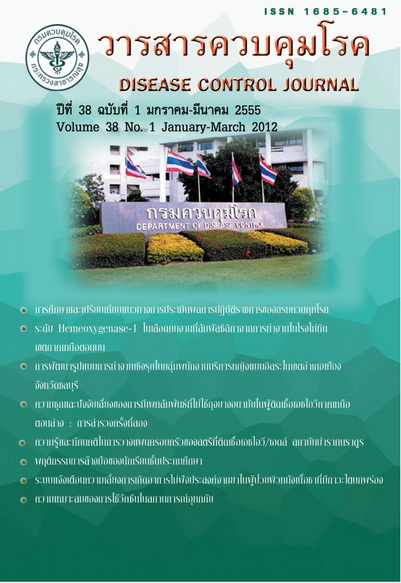Blood Hemeoxygenase-1 (HO-l) Levels in stone Mill Workers who were Exposed to Silica in Upper North Thailand
Keywords:
Hemeoxygenase -1 (HO -1), silica, SilicosisAbstract
งานวิจัยนี้มีวัตถุประสงค์เพื่อค้นหาดัชนีชี้วัด Hemeoxygenase-1 (HO-l) เพื่อการวินิจฉัยการเกิด โรคซิลิโคสิสในระยะต้น ดำเนินการในกลุ่มตัวอย่างเป็นพนักงานที่สัมผัสฝุ่นซิลิกาทางระบบทางเดินหายใจ ขณะปฏิบัติงานในโรงโม่หินใน 7 จังหวัดภาคเหนือตอนบน จำนวน 299 ราย เก็บอนุภาคฝุ่นในบรรยากาศที่ทำงาน จำนวน 3 จุดต่อ 1 โรงงาน จำนวน 9 โรงงาน ตลอดเวลาการทำงาน 8 ชั่วโมง นำมาวิเคราะห์ปริมาณซิลิกาในอนุภาค ฝุ่นด้วยเครื่อง spectrophotometer เก็บเลือดพนักงานเพื่อวัดปริมาณเอนไซม์ Hemeoxygenase-1 (HO-l) ในซีรั่ม ด้วยวิธี ELISA ใช้เทคนิค sandwish enzyme immunoassay เอ็กซเรย์ปอด อ่านผลโดยแพทย์ผู้เชี่ยวชาญ ทดสอบสมรรถภาพปอดของพนักงานด้วยเครื่อง Spirometer วัดคาพารามิเตอร์ทั้งหมด 3 ตัว ได้แก่ FVC FEV1 และ FEV1/FVC หาความสัมพันธ์ระหว่างระดับ HO - 1 กับลักษณะอาการทางคลินิก (ผลจากการ เอ็กซเรย์และผลการทดสอบสมรรถภาพปอด) และปริมาณซิลิกาในบรรยากาศ ทำงานโดยใช้สถิติเชิงพรรณนา ร้อยละและค่าเฉลี่ย และผลการทดสอบสมรรถภาพปอดกับปริมาณซิลิกาในบรรยากาศทำงานใช้สถิติ ANOVA การหาความสัมพันธ์ระหว่างปริมาณ HO-1 ในเลือดและผลการทดสอบสมรรถภาพปอดกับปริมาณซิลิกาใน บรรยากาศทำงานใช้สถิติ Spearman correlation test ผลการวิจัยไม่พบรอยโรคในเนื้อปอดของประชากรที่ศึกษา จากผลเอ็กซเรย์ปอด แต่พบว่าค่าเฉลี่ยของระดับซิลิกาแต่ละโรงงานเท่ากับ 1.30, 1.99, 6.34, 1.10, 15.08, 15.91, 6.31, 11.25 และ 1.67 mg/m3 เกินค่ามาตรฐานของ ACGIH standard (0.025 mg/m3) ค่าเฉลี่ยระดับ HO-1 ในเลือด คือ 320.27+207.68mg/ml ค่าเฉลี่ยของเปอร์เซ็นต์เมื่อเทียบกับค่าทำนาย(Predicted value) ของ FVC และ FEV1 คือ 85.90 + 13.58และ91.58 + 16.76 และค่าเปอร์เซ็นต์ FEVl/FVCLท่ากับ 109.53 ±15.43%ตามลำดับ พบว่า ระดับ HO-1 มีความสัมพันธ์กับระดับซิลิกา และ FEV1/FVC อย่างมีนัยสำคัญ (r =0.419 และ -0.219 p<0.01) แสดงว่าเมื่อได้รับซิลิกาสูงจะทำให้ระดับ HO-1 สูงขึ้น แต่สมรรถภาพการทำงานของปอด (FEV1/FVC) ลดลง จากการศึกษาครั้งนี้ พบความสัมพันธ์ระหว่างค่าระดับปริมาณซิลิกา กับค่า สมรรถภาพปอดและค่าปริมาณ HO-l ในขณะที่ผลการอ่านฟิล์มเอ็กซเรย์ปอดยังปกติ แสดงให้เห็นว่าวิธีการวินิจฉัย การสัมผัสฝุ่นซิลิกา โดยการตรวจค่าปริมาณHO-1 มีความไวพอที่จะนำไปเฝ้าระวังโรคซิลิโคสิสนอกเหนือจากการตรวจวัดค่าสมรรถภาพปอด และยังสามารถทำได้ในพื้นที่ต่าง ๆ
Downloads
References
2. Valavanidis A, Fiotakis K, Vlachogianni T. Airborne particulate matter and human health: toxicological assessment and importance of size and composition of particles for oxidative damage and carcinogenic mechanism. J Environ Sci Heal c. 2008; 26: 339-62.
3. Sato T, Takieno M, Honma K, Yamauchi H, Saito Y, Sasaki T, Morikubo H, Nagashima Y, Takagi ร, Yamanaka K, Kanekol T, Ishigastsubol Y. Heme oxygenase-1, a potential biomarker of chronic silicosis, attenuates silica-induced lung injury. Am J Respir Crit Care Med. 2006; 174(8): 906-14
4. สมาคมอุรเวชช์แห่งประเทศไทย. Guidelines for Pulmonary Function Tests. [Online]. Available: http://www.occmed nop.org/document/ BookSpirometry.pdf (01/08/2009)
5. อภิสิทธ์ มลาสานต์, กาญจนา คงศักดิ์ตระกูล. 2537. โรคซิลิโคสิส (Silicosis) [Online]. Available: http://dpc2.ddc. moph.go.th/option/PSO/ pso2/data/pic/31.doc (01/09/2009)
6. Nagatomo H, Morimoto Y, Oyabu T, Hirohashi M, Ogami A, Yamato H, et al. Expression of heme oxtgenase-1 in the lungs of rats exposed to crystalline. J Occup Health. 2006; 48(2): 124-8.
7. Donnelly LE, Barnes PJ. Expression of heme oxygenase in human airway epithelial cells. Am J Respir Cell Mol Biol. 2001; 24(3): 295¬303
8. Fubini B, Hubbard A. Reactive oxygen species (ROS) and reactive nitrogen species (RNS) generation by silica in inflammation and fibro¬sis. Free Radical Biology and Medicine. 2003; 34(12): 1507-16.
9. Eom 9. HJ, Choi J. Oxidative stress of silica nanoparticles in human bronchial epithelial cell,Beas-2B. Toxicol In Vitro. 2009; 23(7): 1326-32
10. ศิระรัช ภู่กฤษณา. การวิเคราะห์โปรตีโอมิกส์ของ เซลล์แมคโครฟาจRAW26 4.7 อนุพันธ์namda. วิทยานิพนธ์ระดับมหาบัณฑิตมหาวิทยาลัยบูรพา, 2551
Downloads
Published
How to Cite
Issue
Section
License
Articles published in the Disease Control Journal are considered as academic work, research or analysis of the personal opinion of the authors, not the opinion of the Thailand Department of Disease Control or editorial team. The authors must be responsible for their articles.


.png)



